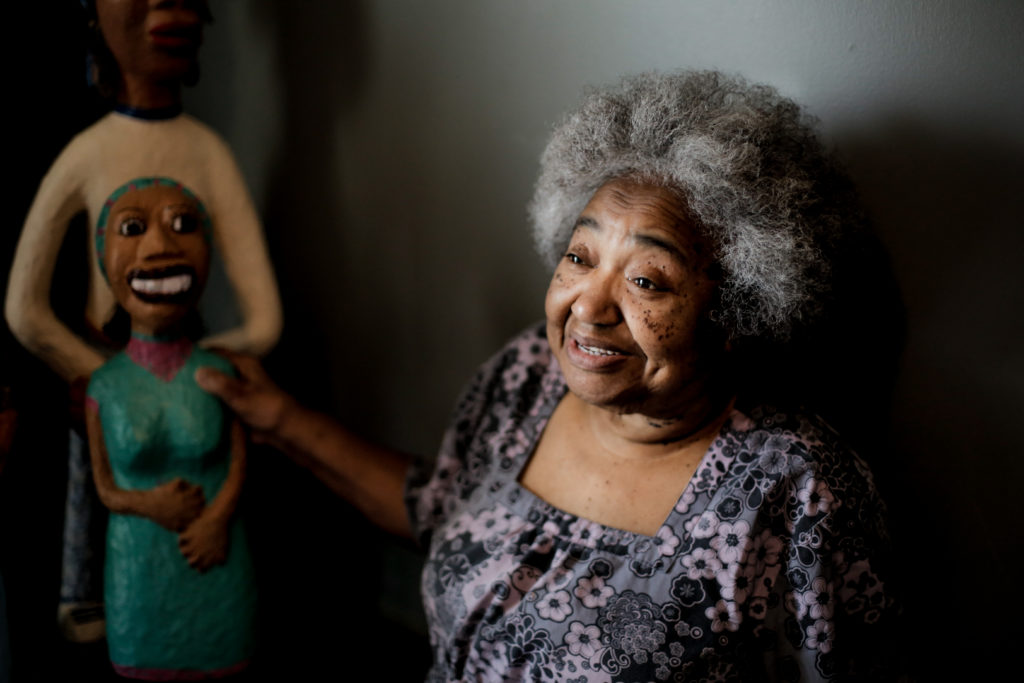 Self-taught sculptor Hattie Marshall-Duncan, of Jackson, turns clay and found objects into highly distinctive masterworks. As a child, she was inspired by the drawings of her father, a sharecropper who was “a folk artist, though he didn’t know it,” according to Hattie. She created art from a young age, but it was not until the late 1990s that she moved into sculpture, for which she is now best known. Hattie began to experiment with making her own “paper clay” in a blender, based on a recipe she saw in a magazine. Using scrap wire, milk jugs, and plastic bottles as the base, she molded the paper clay to create distinctive, visually arresting figures. Once shaped and dried, she completed them with paint and found objects, usually common kitchen items such as eggshells, coffee grounds (for hair), and plastic nets. Thus her unique style of sculpture was born.
Self-taught sculptor Hattie Marshall-Duncan, of Jackson, turns clay and found objects into highly distinctive masterworks. As a child, she was inspired by the drawings of her father, a sharecropper who was “a folk artist, though he didn’t know it,” according to Hattie. She created art from a young age, but it was not until the late 1990s that she moved into sculpture, for which she is now best known. Hattie began to experiment with making her own “paper clay” in a blender, based on a recipe she saw in a magazine. Using scrap wire, milk jugs, and plastic bottles as the base, she molded the paper clay to create distinctive, visually arresting figures. Once shaped and dried, she completed them with paint and found objects, usually common kitchen items such as eggshells, coffee grounds (for hair), and plastic nets. Thus her unique style of sculpture was born.
A deeply religious woman, Hattie trusts her intuition to guide her in her art. Much of her work depicts family and community members who are a vital part of her social network; some of it is fanciful and abstract. All of it is highly evocative and appealing; often amusing, always respectful, and loving. When asked, she often recounts detailed stories about the individuals represented in her work.
Hattie’s work is original and often paradoxical. It is at the same time deeply rooted in and reflective of her local African American community and family life in Jackson, Tennessee. Whimsical and amusing, her figures also suggest a deep spiritual dimension. Her art is a loving tribute to the culture that formed her, the family who raised her, and the men and women in her church. And finally, her art is both humble and ambitious. Humble, because it is composed of common household items, objects that are usually discarded or overlooked. Ambitious, because her creative drive is dedicated, tireless, and productive. When not exhibited somewhere, the fruits of her labor fill every nook and cranny of her house.
Hattie’s artistry is admired statewide by folklorists and folk arts leaders. Her work proudly highlights a rich vein of cultural heritage rarely seen in our state’s art galleries until now. She has exhibited in many important Tennessee galleries, including at the Customs House Museum in Clarksville, the West Tennessee Regional Arts Center in Humboldt, the West Tennessee Delta Heritage Center in Brownsville, and the Latta in Selmer. In 2014, she exhibited in the Tennessee Arts Commission’s gallery. Her work was selected for display at the Tennessee Residence during the holiday season. She was recently chosen to participate as a master artist in Tennessee’s Traditional Arts Apprenticeship Program, an initiative created to preserve rare and endangered art forms. She has been working recently to pass down her unique technique and style to the next generation, her daughter, Keesha.

